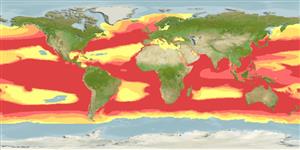Coastal over continental and insular shelves and epipelagic far from land (Ref. 30573, 43278, 58302). Oceanic although most abundant near land, pelagic at 1-366 m (Ref. 58302). Young often close inshore and in shallow bays (Ref. 5578). Feeds on schooling fishes (including mackerels, bluefishes, clupeids, needlefishes, lancetfishes and lanternfishes), squid, octopi, pelagic crustaceans, and rarely seabirds (Ref. 247). Ovoviviparous, embryos feeding on yolk sac and other ova produced by the mother (Ref. 43278, 50449). Uses its long caudal fin to bunch up and stun prey (Ref. 2850). Spatial and depth segregation by sex in northwestern Indian Ocean populations (Ref. 247). A few attacks on boats are doubtfully attributed to this species, but it is otherwise apparently harmless to humans, though the size of adults of this species command respect (Ref. 247). May cause damage to fishing gear (Ref. 6885). Valued for its meat, liver, hide, and fins; utilized fresh, dried-salted, smoked, and frozen (Ref. 9987).
海岸的大陆架与岛屿棚之上与表层带远离土地。 (参考文献 30573) 幼鱼时常近岸与在浅湾中.(参考文献 5578) 吃群游性鱼 (包括鲭,跳鱼,鲱鱼,颌针鱼,柳叶鱼与灯笼鱼) ,乌贼,章鱼,大洋性甲壳动物, 与很少地海鸟.(参考文献 247) 卵胎生的, 胚胎吃产生于母亲的卵黄囊与其他的卵.(参考文献 50449) 使用它的长尾鳍串起而且打昏猎物。 (参考文献 2850) 在在西北部的印度洋族群的性别空间深度分离.(参考文献 247) 一些对船的攻击是归因于可疑的这种,但是否则对人类,它显然无害处, 虽然这种的成鱼的大小值得重视。 (参考文献 247) 可能引起对渔网的伤害。 (参考文献 6885) 重要的是它的肉 , 肝脏,隐藏, 与鳍; 生鲜利用 , 乾燥盐腌,烟熏了, 与冷冻.(参考文献 9987)
Preferred temperature (Ref.
115969): 11.6 - 28.2, mean 23.3 (based on 8352 cells).
Phylogenetic diversity index (Ref.
82804): PD
50 = 0.7500 [Uniqueness, from 0.5 = low to 2.0 = high].
Bayesian length-weight: a=0.00851 (0.00363 - 0.01997), b=2.86 (2.66 - 3.06), in cm Total Length, based on LWR estimates for this species & (Sub)family-body (Ref.
93245).
营养阶层 (Ref.
69278): 4.5 ±0.0 se; based on diet studies.
回复力 (Ref.
120179): 低的, 最小族群倍增时间4.5 - 14 年 (K=0.1; tm=5-7; tmax=19; Fec=2-4).
Prior r = 0.05, 95% CL = 0.03 - 0.07, Based on 1 full stock assessment.
Fishing Vulnerability (Ref.
59153): Very high vulnerability (77 of 100).
Climate Vulnerability (Ref.
125649): High vulnerability (62 of 100).
